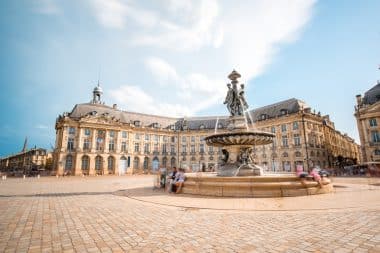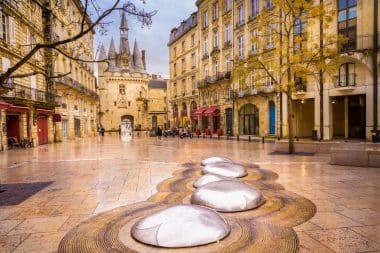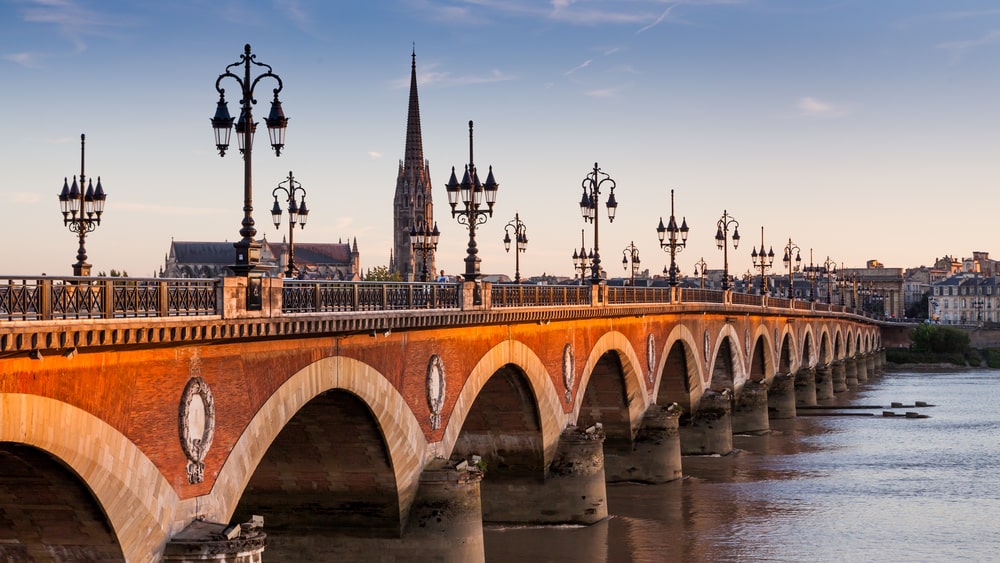In the middle of the French region of Nouvelle-Aquitaine lies historic Bordeaux, home to about 260,000 inhabitants. If you take the metropolitan region together, Bordeaux even breaks through the wall of over 1.2 million inhabitants – one of the largest settlements in western France. Historical sights such as the Place de la Bourse, the Pont de Pierre and the Cathédrale Saint-André prove that Bordeaux is at the top of the list of French cultural cities. Bordeaux is more than just a name for gourmets and wine connoisseurs: thanks to the famous Bordeaux wine, the hearty oysters and the sweet canelés, the city is an extraordinary culinary stop for visitors.
Old Town and Place de la Bourse – The historic heart of Bordeaux

The highly respected title of UNESCO World Heritage Site has been held by the old town of Bordeaux since 2007. The award refers in particular to the historic core that unfolds within the old city walls. Nestled against the natural meanders of the Garonne River is the city’s historic architecture, defined by striking streets and old walls. Architecturally interesting are the old city gates Grosse Cloche and Porte Cailhau. The Great Cloche owes its name to the gigantic eight-ton bell, and the former historic town hall tower now towers over the cityscape, visible from afar.
In the late 15th century, the Porte Cailhau was built, which is now one of Bordeaux’s famous landmarks and monuments. When it comes to the city’s great landmarks, the name Place de la Bourse comes up again and again. The large square was built directly on the Garonne River in the 18th century. The historic harbour stock exchange once existed here, but today the square with its large fountain is considered evidence of the special classicist architecture of the 18th century. Under Napoleon, the Pont de pierre was built on the Garonne between 1819 and 1821, the stone bridge steeped in history, which is now only open to pedestrians and cyclists and invites you to stroll along the banks of the river. One thing is clear: The old town of Bordeaux has impressive facets to offer for fans of historical sightseeing. For example, there is the Cathédrale Saint-André, whose construction stretched from the 12th to the 15th century. Today, the Romanesque-Gothic façade is one of Bordeaux’s most important monuments – and is undoubtedly the largest and one of the most fascinating sacred buildings in the city.
Modern Bordeaux and its beaches, museums and places to visit

Bordeaux, however, is not only made up of the old town. This is exactly what makes the versatile city so attractive to tourists. Within Bordeaux, prominent buildings of modern architecture can be discovered. These include museums such as the Cité du Vin, the city’s wine museum – which also offers wine tastings of regional varieties. When it comes to the museums of Bordeaux, the Musée des Beaux-Arts is worth mentioning, which houses works by Rubens, Renoir, Matisse and Picasso.
Above all, the immediate destinations revolve around Bordeaux, but with Saint-Émilion there is also a fascinating cultural settlement in the vicinity of Bordeaux. About three-quarters of an hour’s drive away is the village, whose wine-growing region and settlement are now UNESCO World Heritage Sites. Here you will find a historic rock church and the facades of a historic place that was already known under the Romans for its viticulture. Bordeaux itself scores with an exposed coastal location, in fact the city is not far from beautiful Atlantic beaches. Beach holidays can be experienced on nice days at Archachon Bay, which is not even a kilometre away, a popular destination for sea holidaymakers. But not only touristically, but also culinarily, the sea at the Bay of Archachon – and the oysters it contains – is characteristic of the region.
Wine and specialities – Culinary Bordeaux
The magnificent wines of the Bordeaux region are born in the vineyards of the Médoc. Located directly on the Atlantic Ocean, the aromas of French Bordeaux wines from grape varieties such as Carbernet-Sauvignon to Merlot unfold here on carefully cultivated vines. The tradition of these western French wines can be traced back to Roman times. Unquestionably: For wine fans, a visit to the region is an absolute must. In general, the region is extremely multifaceted in culinary terms, Bordeaux is a paradise for gourmets. A typical Bordeaux wine is sometimes accompanied by specialities such as the oysters of the Bay of Archachon. Fresh seafood is typically part of the menus of regional restaurants. The Boeuf de Bazas, the beef from the region that is considered very tender, is also often served with regional wine. Popular desserts include the Cannelé caramel cakes and the Noisettine de Médoc nut chocolate. All of this – from the UNESCO-listed old town to the coastal location and the culinary richness – are good reasons to visit Bordeaux


